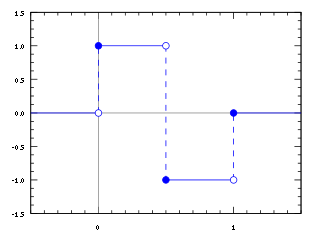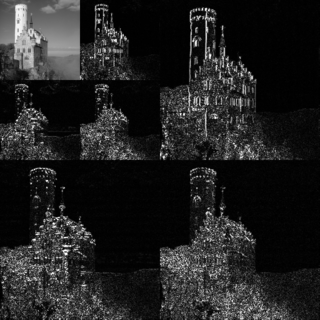
A wavelet is a wave-like oscillation with an amplitude that begins at zero, increases or decreases, and then returns to zero one or more times. Wavelets are termed a "brief oscillation". A taxonomy of wavelets has been established, based on the number and direction of its pulses. Wavelets are imbued with specific properties that make them useful for signal processing.

In mathematics, the Haar wavelet is a sequence of rescaled "square-shaped" functions which together form a wavelet family or basis. Wavelet analysis is similar to Fourier analysis in that it allows a target function over an interval to be represented in terms of an orthonormal basis. The Haar sequence is now recognised as the first known wavelet basis and is extensively used as a teaching example.

In mathematics, the Morlet wavelet is a wavelet composed of a complex exponential (carrier) multiplied by a Gaussian window (envelope). This wavelet is closely related to human perception, both hearing and vision.

In mathematics, the continuous wavelet transform (CWT) is a formal tool that provides an overcomplete representation of a signal by letting the translation and scale parameter of the wavelets vary continuously.
A Mexican hat is a sombrero – a broad-brimmed and high-crowned hat.

In mathematics and numerical analysis, the Ricker wavelet
Hermitian wavelets are a family of discrete and continuous wavelets, used in the continuous and discrete Hermite wavelet transform. The Hermitian wavelet is defined as the derivative of a Gaussian distribution for each positive :where in this case the (probabilist) Hermite polynomial can be considered.
In applied mathematics, the complex Mexican hat wavelet is a low-oscillation, complex-valued, wavelet for the continuous wavelet transform. This wavelet is formulated in terms of its Fourier transform as the Hilbert analytic signal of the conventional Mexican hat wavelet:
Stransform as a time–frequency distribution was developed in 1994 for analyzing geophysics data. In this way, the S transform is a generalization of the short-time Fourier transform (STFT), extending the continuous wavelet transform and overcoming some of its disadvantages. For one, modulation sinusoids are fixed with respect to the time axis; this localizes the scalable Gaussian window dilations and translations in S transform. Moreover, the S transform doesn't have a cross-term problem and yields a better signal clarity than Gabor transform. However, the S transform has its own disadvantages: the clarity is worse than Wigner distribution function and Cohen's class distribution function.
Alexander Grossmann was a French-American physicist of Croatian origin.
Jean Morlet was a French geophysicist who pioneered work in the field of wavelet analysis around the year 1975. He invented the term wavelet to describe the functions he was using. In 1981, Morlet worked with Alex Grossmann to develop what is now known as the Wavelet transform.

In mathematics, a wavelet series is a representation of a square-integrable function by a certain orthonormal series generated by a wavelet. This article provides a formal, mathematical definition of an orthonormal wavelet and of the integral wavelet transform.
Modified Mexican hat, Modified Morlet and Dark soliton or Darklet wavelets are derived from hyperbolic (sech) and hyperbolic tangent (tanh) pulses. These functions are derived intuitively from the solutions of the nonlinear Schrödinger equation in the anomalous and normal dispersion regimes in a similar fashion to the way that the Morlet and the Mexican hat are derived. The modified Morlet is defined as:
In applied mathematics, Gabor atoms, or Gabor functions, are functions used in the analysis proposed by Dennis Gabor in 1946 in which a family of functions is built from translations and modulations of a generating function.

In mathematics and signal processing, the constant-Q transform and variable-Q transform, simply known as CQT and VQT, transforms a data series to the frequency domain. It is related to the Fourier transform and very closely related to the complex Morlet wavelet transform. Its design is suited for musical representation.
The wavelet transform modulus maxima (WTMM) is a method for detecting the fractal dimension of a signal.
Gabor wavelets are wavelets invented by Dennis Gabor using complex functions constructed to serve as a basis for Fourier transforms in information theory applications. They are very similar to Morlet wavelets. They are also closely related to Gabor filters. The important property of the wavelet is that it minimizes the product of its standard deviations in the time and frequency domain. Put another way, the uncertainty in information carried by this wavelet is minimized. However they have the downside of being non-orthogonal, so efficient decomposition into the basis is difficult. Since their inception, various applications have appeared, from image processing to analyzing neurons in the human visual system.
In signal processing it is useful to simultaneously analyze the space and frequency characteristics of a signal. While the Fourier transform gives the frequency information of the signal, it is not localized. This means that we cannot determine which part of a signal produced a particular frequency. It is possible to use a short time Fourier transform for this purpose, however the short time Fourier transform limits the basis functions to be sinusoidal. To provide a more flexible space-frequency signal decomposition several filters have been proposed. The Log-Gabor filter is one such filter that is an improvement upon the original Gabor filter. The advantage of this filter over the many alternatives is that it better fits the statistics of natural images compared with Gabor filters and other wavelet filters.






